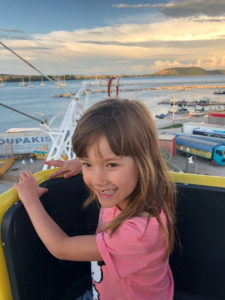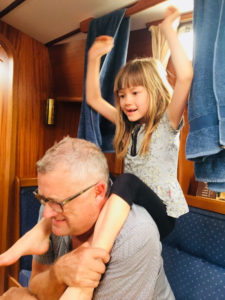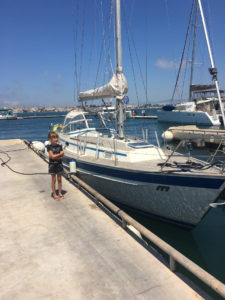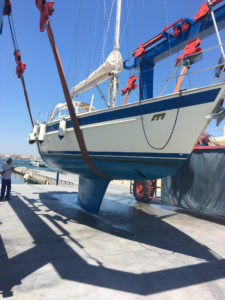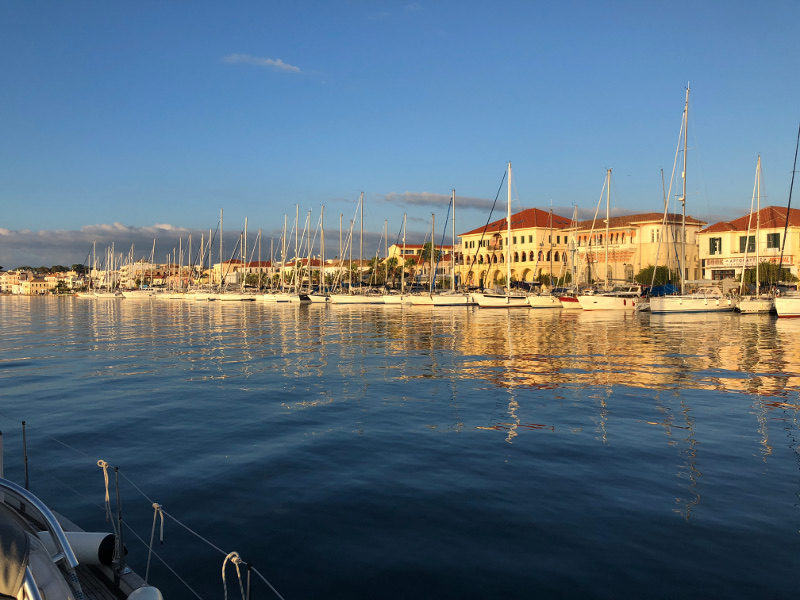
After three years in the Mediterranean we make Ronja ready for Mediterranean sailing
38° 57′ 27.7884” N 20° 45′ 26.4132” E
July 12th
“If it’s a difficult harbour? It is the most difficult in the whole of the Mediterranean,”declares the port assistant who helps us into Cleopatra Marina. “We have measured currents of up to 11 knots,” he adds. It sounds crazy, but he has worked in several ports, so he lets us understand that he knows, what he is talking about.
It is the Cleopatra Marina’s location in the strait, that leads from the open sea and into the big bay, Amvrakikos Kolpos, which makes the port seem difficult to maneuver. Winds and currents become more concentrated as they pass the narrow strait with the city of Préveza on one side and the peninsula Aktion on the other side.
For us, it does not matter. We are here just to get Ronja lifted on land at the end of this year’s sailing. Here she will stay for nine months, until April 2019, on a large, dusty car park for pleasure boats. It seems to us that hundreds or even a thousand boats are parked here on each of their stands, while waiting for their owner to afford or having time to put them back into the water.
We have decided, that Ronja shall have extra service and have completed some enhancements while she is on land at Cleopatra Marina. She has been underway from Denmark for six years, she has sailed in the Mediterranean for three years, and now now what is needed make her a real Mediterranean sailing boat.
Ronja was built in Sweden, built to keep away hard and cold weather, to anchor at relatively shallow water, to create warmth inside rather than coolness and to sail in waters with lower content of salt than the Mediterranean. In the Mediterranean, it’s about keeping the heat away, being open to any cool breeze, and to anchor frequently and in relatively deep water.
- Granddauhter Nellie likes to sail. But Prevezas funpark is better
- WM in football is watched on the computer
We therefore meet Cleopatra Marina with a pretty long wish list, that we want the yard to give us a quotation for. The main points are:
We need a longer anchor chain. In the Mediterranean, our 40 meter chain is simply not enough. We must have it extended to at least 60 meter chain. At the same time, we need to strengthen our secondary anchor system, the stern anchor, which currently has only three meters of chain plus ten meters of rope. It is not even near, what is needed in the Mediterranean. We must have at least six meters of chain and 20 meters rope for the stern anchor.
In addition, we sometimes feel, that we are the only ones in the whole of the Mediterranean, who are still throwing anchor and, not least, pulling it up by hand. Everyone else leans comfortably to the forestay while they – with a remote control in the hand – lower and raise their anchor by electricity. Come on. I’ve just reached 66. Kirsten is 64. We want that such an electric windlass as well.
And then there is the cockpit tent and sprayhood. Also here is the current build to keep wind, rain and cold away, but in the Mediterranean we need openness, plenty of fresh air, open sides, shade – even while we’re sailing – and high ceilings. So we ask for the price of a brand new set up with a so-called bimimi as the focal point. And when we are in the process, we ask for the price of a solar panel on top of the bimimi, because in Denmark anchoring was one thing we did occasionally and only for one night, anchoring in the Mediterranean is something we do several times week and would love to do for more than one night. This requires energy to keep on the fridge, pumps and reading lights, and this can be provided by the sun.
Further we would like to have a shower on the bathing platform. In Denmark it was okay to the take a bath in the bathroom, when we had taken a swim. But in the Mediterranean, the water is really salty, and salt puts traces all over the boat, unless you rinse it off in fresh water immediately. We have noticed that all southern European boats are equipped with a freshwater outlet near their bathing platform, so as a natural routine, they rinse off before getting into the cockpit and cabin. You must possible have tried it, in order to see the importance of this issue.
We also ask for offers to improve our electrical system. We would like a 220 volt outlet at the chartboard, we would like to have 12 volts charging of mobile phones and VHF radios and we would like to install two small 12 volt fans in the main cabin to ensure coolness even when we do not have access to land electricity.
Beside all this, we ask for a service on Ronja’s inboard engine, in particular the starting motor that, 20 years old, has begun to be unstable, and also the outboard engine, that has apparently dirt in the carburetor.
- Nellie watches for her first time Ronja beeing lifted to land
- Ronja on her way to nine months of hard-stand in Cleopatra Marina
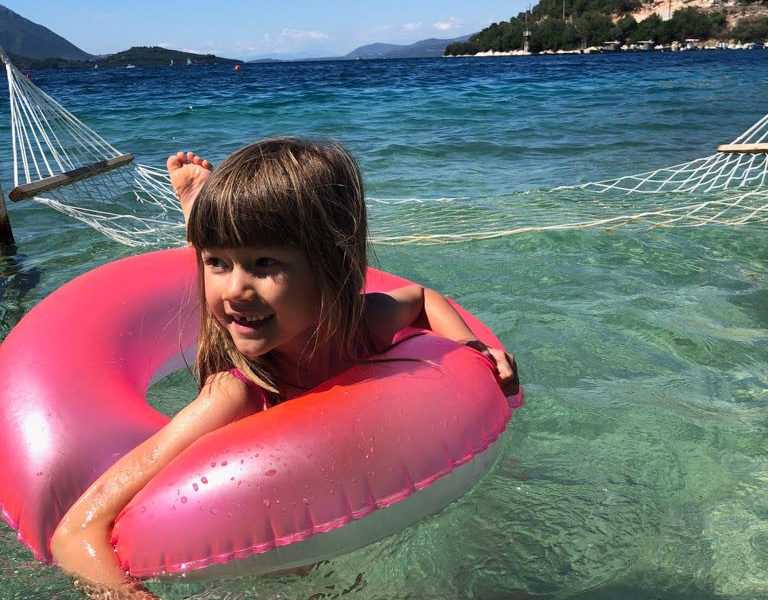
We are mooring at a tavern
38° 39′ 44.1504” N 20° 45′ 33.066” E
28th of June
Three times in just a few weeks we visit Port Spiglia, located in an enchanting bay on the north side of the island of Meganisi. We have got the place recommended by Bob and Ann, an English couple, whom we met in Prevéza on the mainland. They sail every spring and autumn, and when they tell us, they have sailed in the Ionian Sea for 16 years, the first many years in a rented boat, and the latest in their own boat, Coconut, we ask if they have some recommendations for a couple of Danes newly arrived in the Ionian Sea.
If they have!

Skippers wife with the sole ruler of harbour as well as restaurant at Port Spiglio, Babis himself
Ann sets out and writes a nothing less than a short story about all the good places – six handwritten pages with anchorages, ports, beaches, eateries, phone numbers. We are now the happy owners of a personal guide to the Western Greece.
We start with Porto Spiglia on the island of Meganissi. “Call Babis,” says Ann’s list of ionic top experiences. Babis is the owner of a tavern, which is so close to the bay, that the water almost licks our feet when we eat. He owns and manages the excellent tavern, but at the same time he acts as harbor master for 50-60 berths along the quay and floating bridges.
We call Babis and say hello from Bob and Ann – and we get a berth in what is unofficially called “the British sector”. Mooring is free and so is electricity and water. But we are expected to eat in the tavern. Fair deal. Super concept.
Life is simple, when you are in Babis’ universe. You exchange experiences with your neighbors, most of them British but also some Norwegians, Swedes and Dutchmen. You take a walk to the high-lying village of Spartakori overlooking the part of the Ionian Sea, go to the beach at the tavern or you walk to the somewhat larger beach in the bottom of the bay, and in the evening you eat at Babis’ tavern, often with some sailors you have met before.
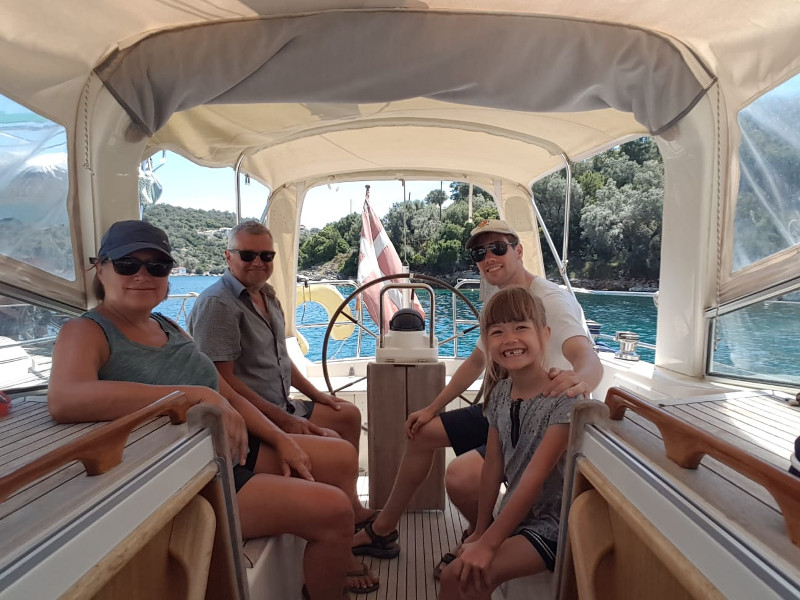
If the bay becomes too tight, you rent a motorcycle or a car and explore the small island and its many beaches. Rarely on our entire boat trip have we come that far down in gear as in the universe of Babis.
That’s why we come back, when we a little later in June, have got our granddaughter, Nellie, six years old, onboard Ronja.
Beach, swimming, eating, reading in Harry Potter. It will not be much better.
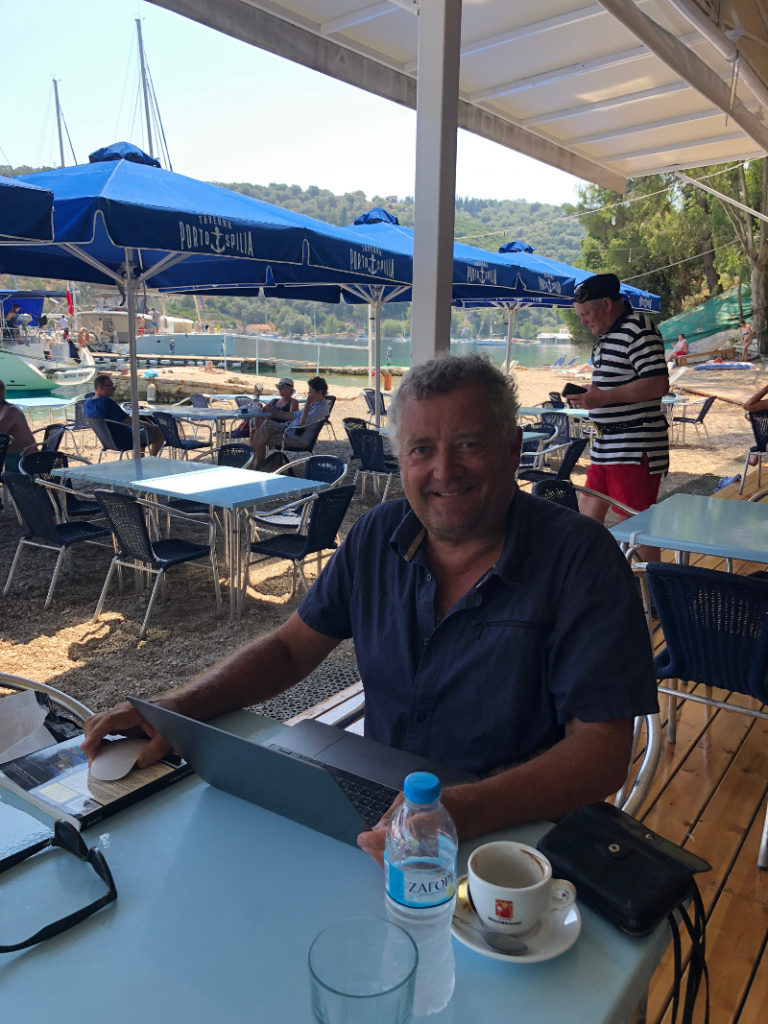
And come back again, when Nellie’s father arrives in July to participate in the sailing.
We also call a few times in Vahti, the main city on the island of Meganisi. Here we call – again according to directions and phone numbers from Ann’s handwritten guide – Karnayio Tavern, and again we experience the special Greek phenomenon, that a tavern operates the quay and let you have a free berth, if eating at the tavern, which is no problem when the food is both good and cheap. That is what we sailors call a wind-wind situation.
Bonus info: There are many grasshoppers at Meganisi, and in Karnayio Tavern at Vahti they like to board your boat. We thought they were innocent, until we asked the tavern owner, whether they had mice, because we could see that someone had been in some of our food and had left excrements in the boat. No, she said. It is grasshoppers. They eat everything, food, clothes, mattresses. Do not ever have sympathy for them. They do a lot of damage. The next time Nellie and Per jump ashore, they scare a grasshopper beyond the railing and discover to their great astonishment that it is actually a good swimmer, but they also observes that after 15 swimming strokes it is – haps – eaten by a fish. Nellie is quite absorbed by the incident, but understands that this is part of the food chain of nature. Maybe we are going to have fish for dinner tonight?
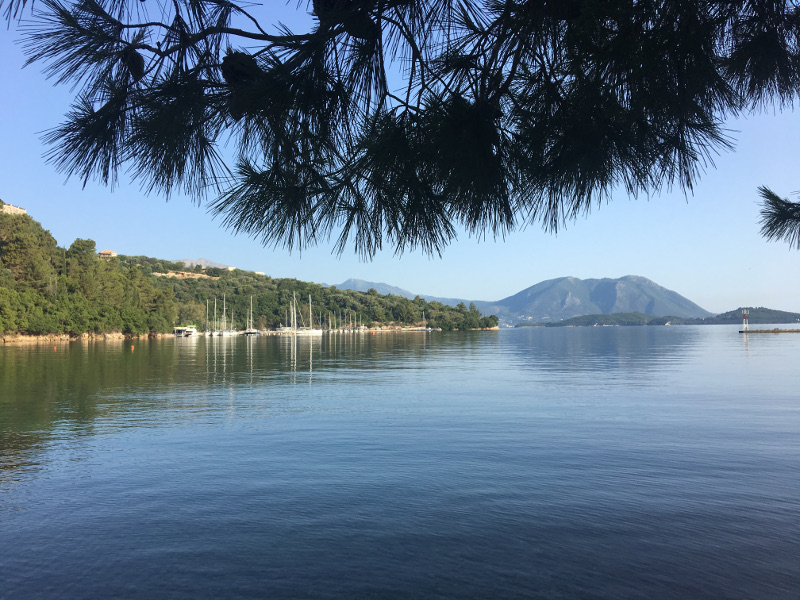
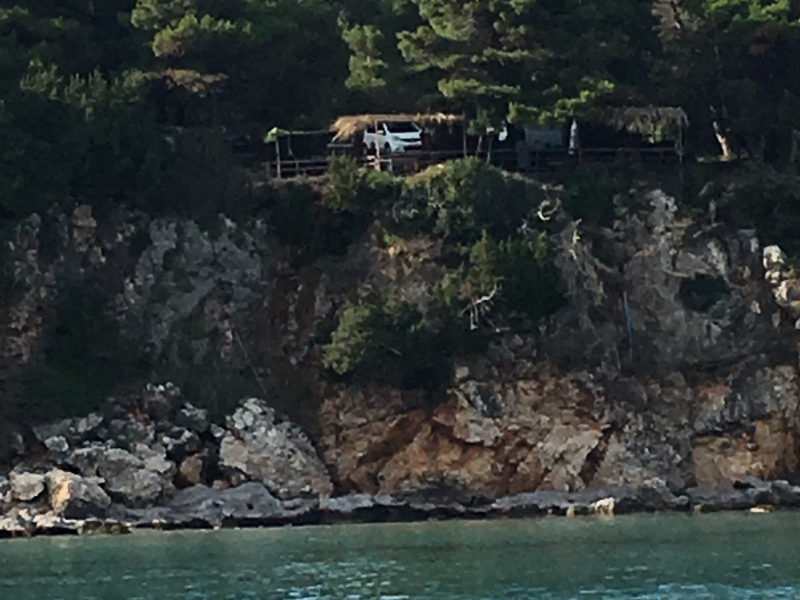
In the deepest calm of the forest
39° 12′ 36.306” N 20° 29′ 31.5024” E
June 8, 2018
Do not tell anyone: Eight nautical miles south of Parga is a bay so beautiful and undisturbed, that we have hardly experienced anything more peaceful and enchantingly beautiful throughout our hole journey with Ronja. Two Rock Bay is the name of the bay.
When we arrive, there is only one boat in the whole bay, an Englishman, who shouts at us that if we want to stay overnight in the bay, we must be prepared for swells, that will make the night uneasy. It is not going to be a problem for us. We drop our anchor furthest into the bay with only 0.9 meters of water below the keel encircled by almost vertical wooded rock walls.
The whole compass around we see no buildings, no sunbeds, no noisy speedboats. Only rock walls, dense forests and small pieces of beach. As the day turns into evening, more and more yachts pop up to sleep in the bay and a young couple raises a small dome tent on the beach and turns a fire on. But even with this increased population, the bay maintains its majestic silence.
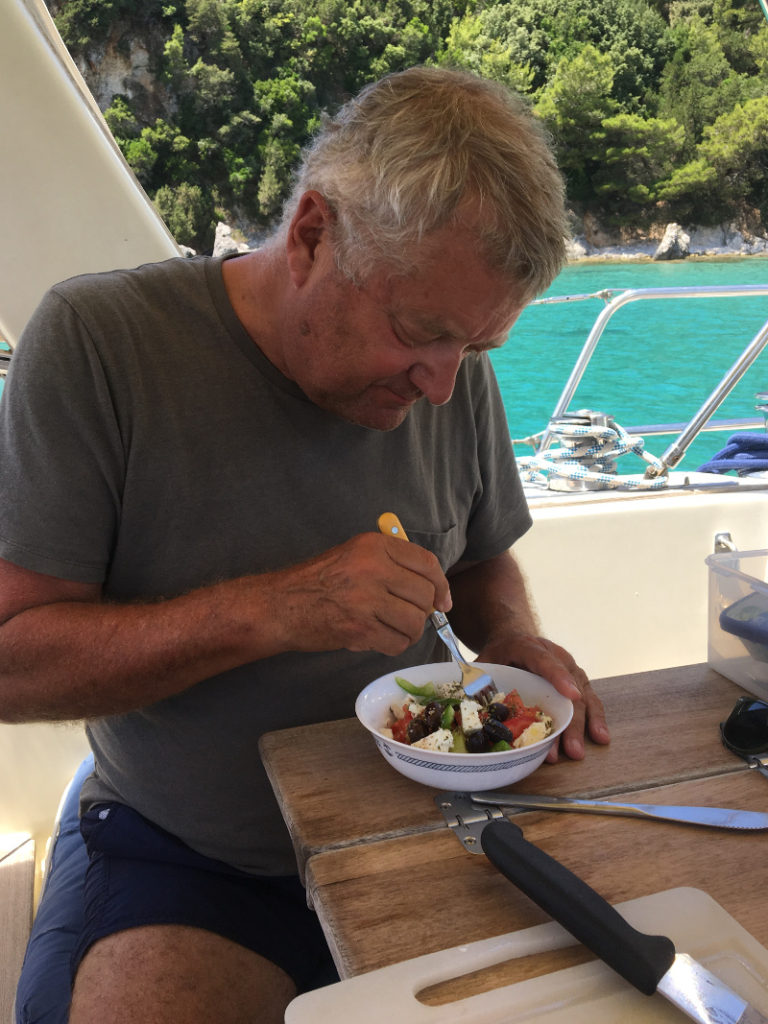
Greek salad for breakfast, lunch and dinner. Skipper realises, that he has left Italy and arrived in Greece
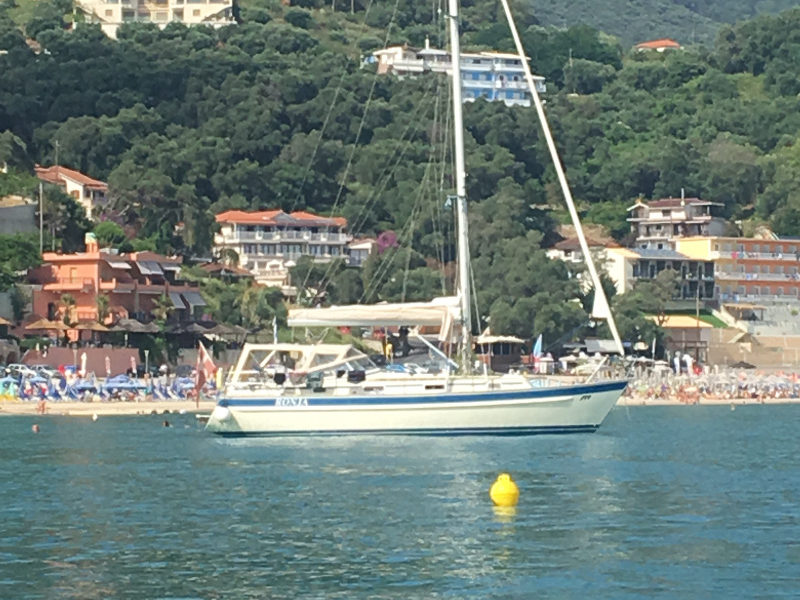
One day in a water park
39° 16′ 59.6532” N 20° 23′ 24.7812” E
5th of June
After an enchanting day with the sails up we anchor in the bay of Valtou near Parga town in mainland Greece, 15 miles west of Paxos. The wind decided, that it would become Parga.
Parga/Valtou is a 110 percent holiday destination. If you want to sunbathe on a sun lounger, swim in the azure green sea, practice water skiing, paragliding, surfing, paddling on a board or being speedboat-pulled in a plastic ring with staggering speed, Valtou is just the right place for you.
Holiday mood is great. We enjoy the stay in the bay. But after a walk to Parga city, we think that this is too much. What a difference there is between islands without an airport, and the mainland where travel agencies create an industrial air bridge of tourism because the distance to an airport is short. It gives a massive tivoli atmosphere, and you are constantly called upon by dozens of offensive tavern owners, who all want you into his or her tavern. Too much.
if we are ever again in this part of Greece with our grandchildren, we will remember Parga as an eldorado of play possibilities at beach level.
But we ourselves decide to leave Parga and seek new adventures.
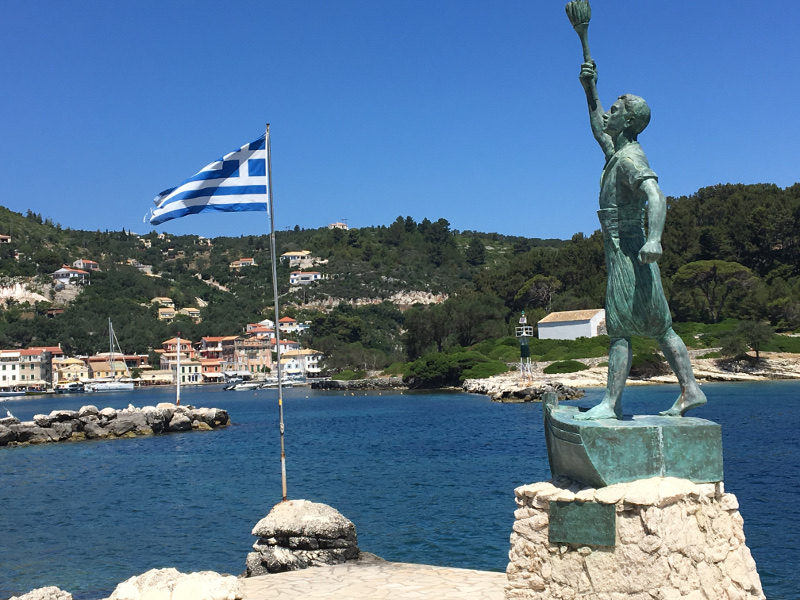
Ronja’s crew surrender – and go backwards into the berth
39° 12′ 6.9444” N 20° 11′ 11.0868” E
June 3rd, 2018
Paxos is a fantastic island. It’s small, it’s kind, it’s lush, and it has only one and a half harbour, so it provokes us to anchor a lot in the most beautiful bays. Here we do not count Longos as a real harbour, because it is said to be reserved for tripper-boats, Lákka count as the half port, and the whole port is Gaios. The port of the island’s capital village, Gaios, has the shape of a river that winds within an island, where you can choose whether you want to lie among fishing boats in the outskirts of the village or you want to go into the village center and mingle with the big yachts.
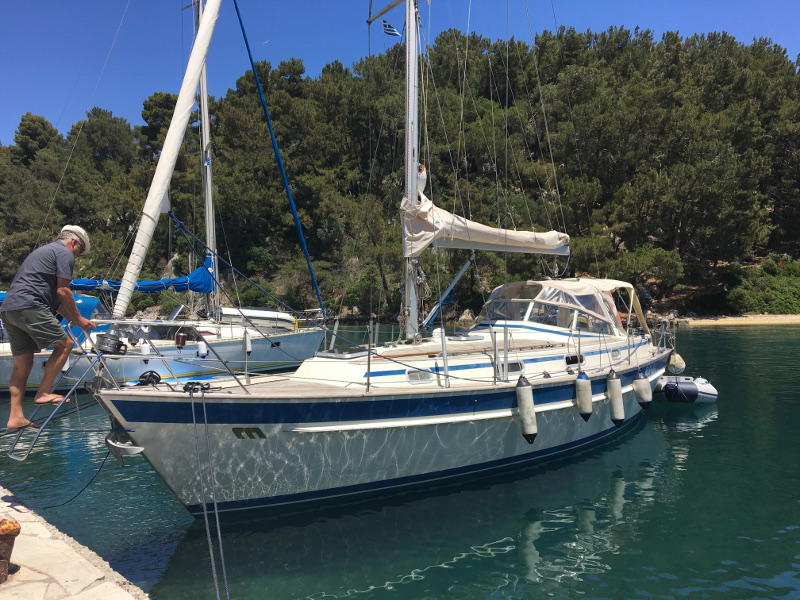
While everything is still calm. Minutes later the wind goes up, the kedge anchor drags … and we are hurrying out of the harbor
We start mingling with the big yachts, and we use our kedge anchor from the stern, as we have done several times in the Swedish archipelago. Out with the anchor behind the boat, then slowly forwards towards the quay with the frontend first, and then a pair of lines to the quay. That’s the way to do it! “Ho, ho,” we giggle. One more time we have shown the South Europeans, that they are wrong in their unbelievable love for always backing their boats into the berth with an anchor from the forehead and then a couple of lines from the boat’s back end to land.
One more time we have shown, that we put our hat and boat as we please. “The Scandinavian model”.
But Paxos shall be the place, where we lose our faith in the superiority of “the Scandinavian model”. In the afternoon the wind is raising, the shape of the harbor as a river with land on both sides creates a wind tunnel that pushes us from the side, we can see that the kedge anchor is losing its grip to the bottom, and suddenly we are heading towards a neighboring boat. We start the engine, pull up the anchor, accurately avoid the neighbor’s anchor chain and moves Ronja outside the harbor, where we throw the bower anchor (front) in a quiet and beautiful anchor bay.
The next morning we try again. We sail into the port of Gaios, find us a new berth, this time throws the bow anchor instead of the stern anchor and goes BACKWARDS into the berth. Like the Greeks. The southern European model.
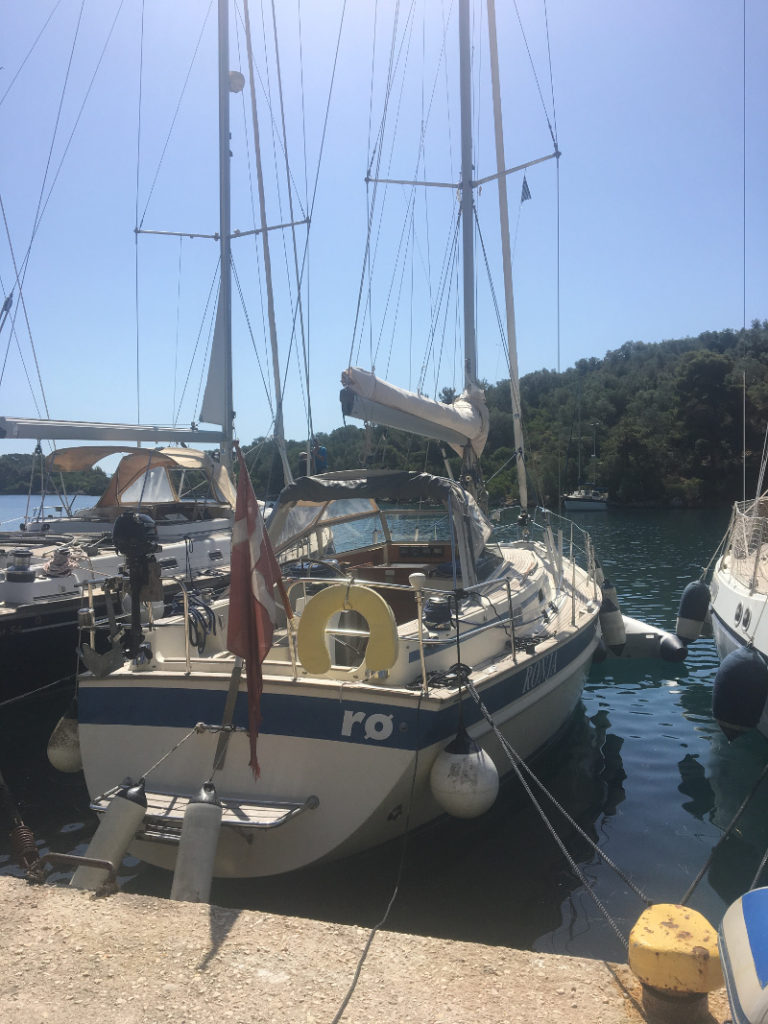
We have learned the lesson: When in Greece do as the Greeks, and sail backwards into your berth
Now we have been sailing for two years in southern France and throughout Italy, and apart from twice, we have succeeded in insisting, that we belong to those who go to a berth with the front end first. Now, however, we have come to a country that does not use fixed mooring lines attached to the port bottom, and where you therefore have to use your own anchor, and here we must acknowledge that our stern anchor is smaller, have a shorter chain and therefore is not as strong as our bow anchor.
We have learned the lesson. When in Greece, do like Greeks: Sail backwards!!
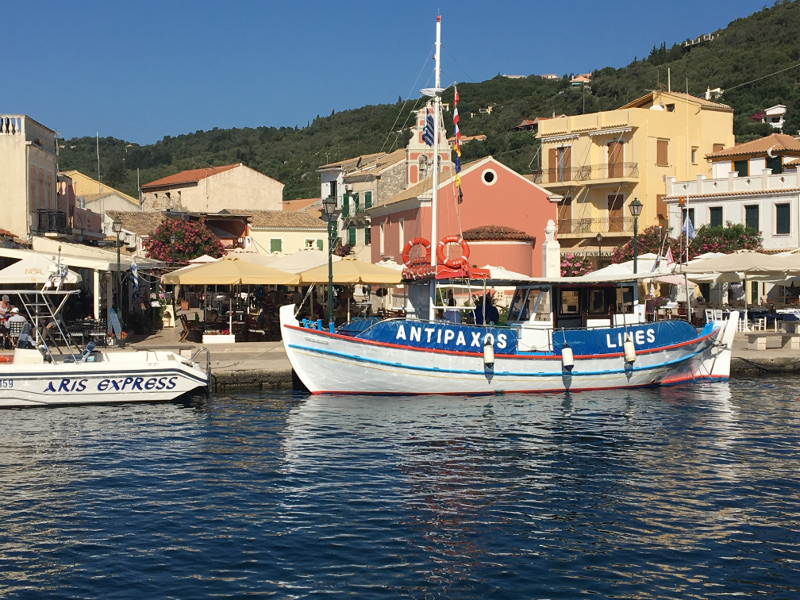
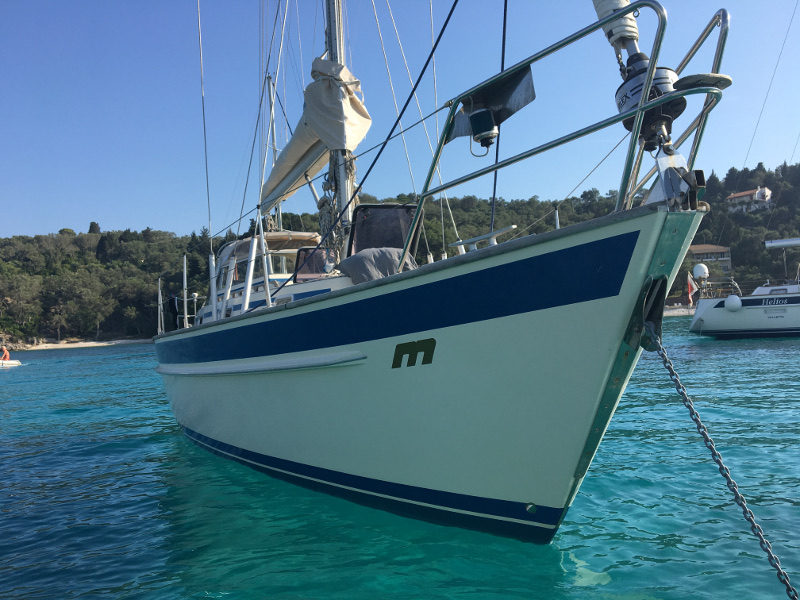
Lakka at Paxos – the most beautiful ankering
39° 14′ 13.2468” N 20° 7′ 57.8856” E
May 31th 2018
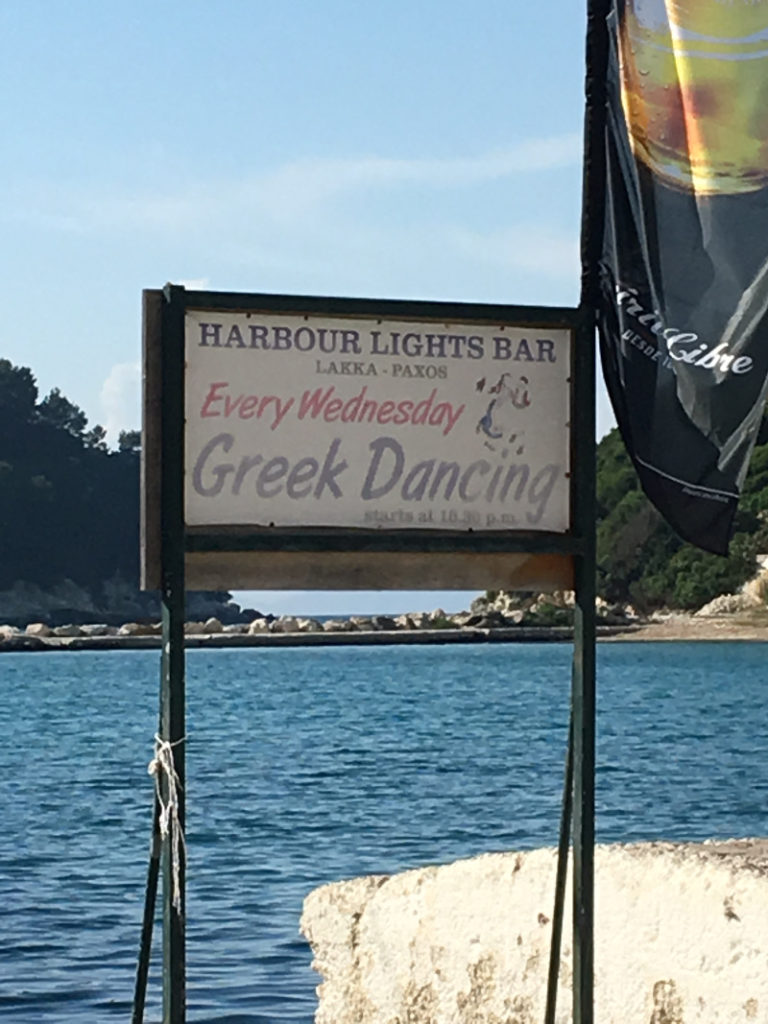
The people in the city of Lakka make a living of the many tourists who come either in their own boat or in one of the many tripperboats. Along the quayside of the city is one tavern next to the other, ready to enjoy the tourists.
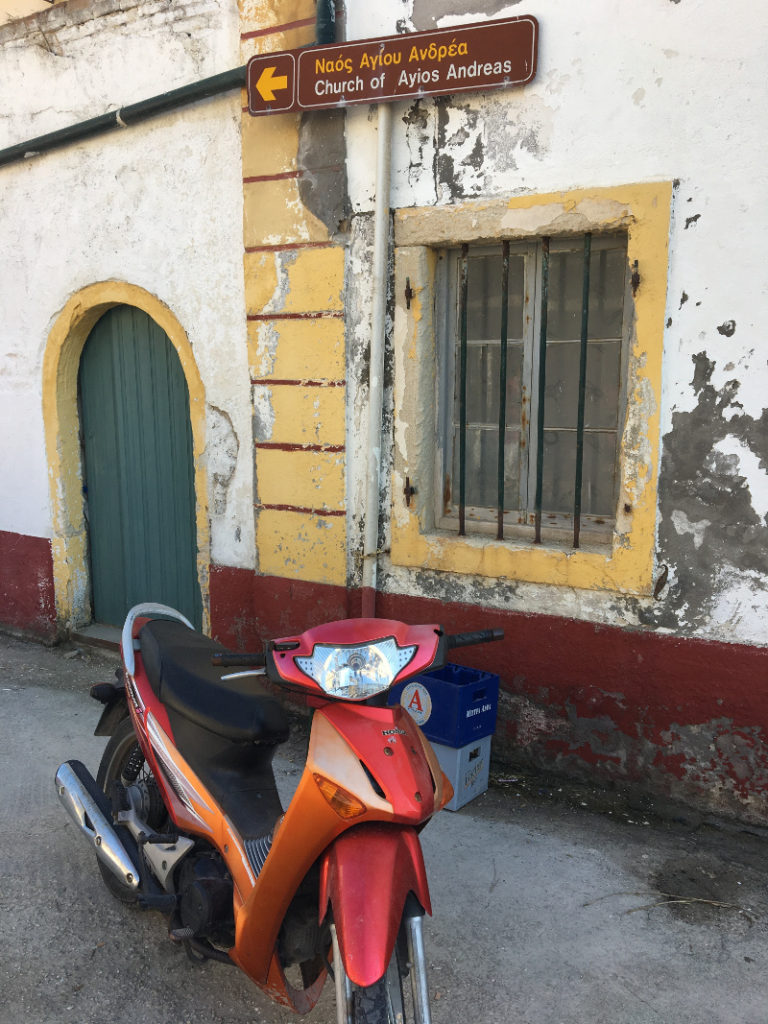
Many houses in the town needs a little painting
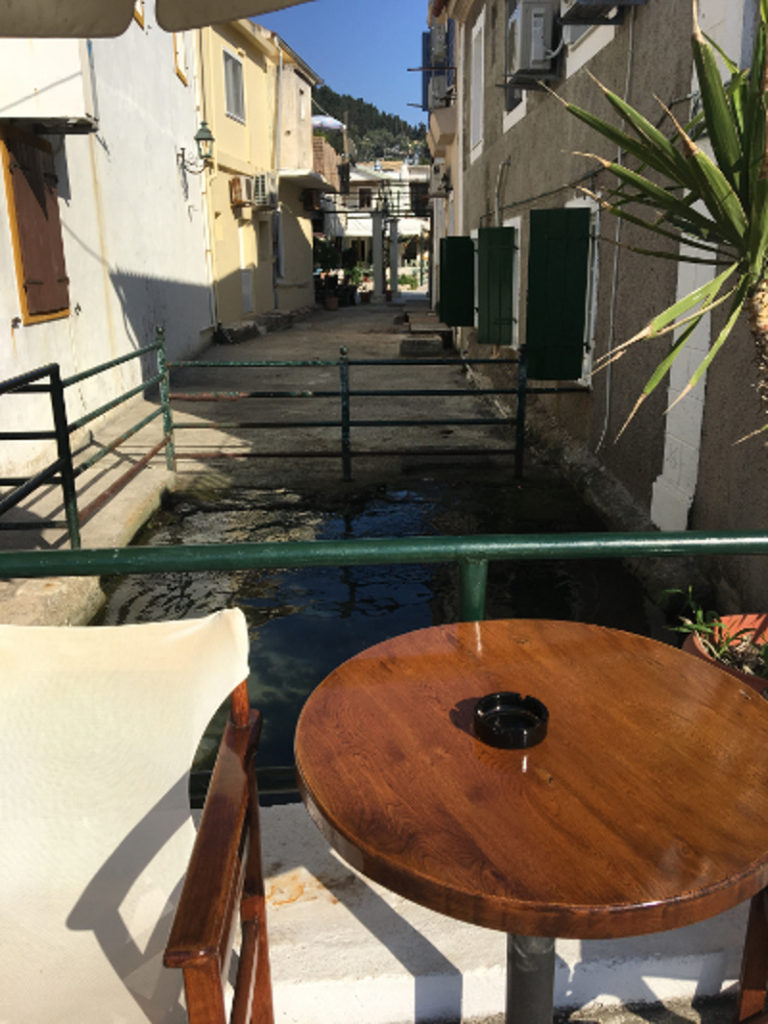
The water goes all the way up the street
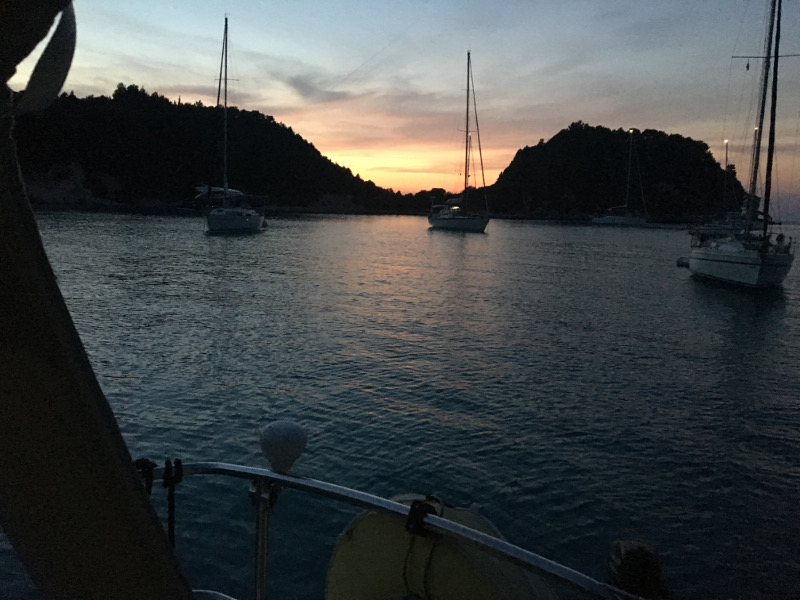
Sunset at Lakka
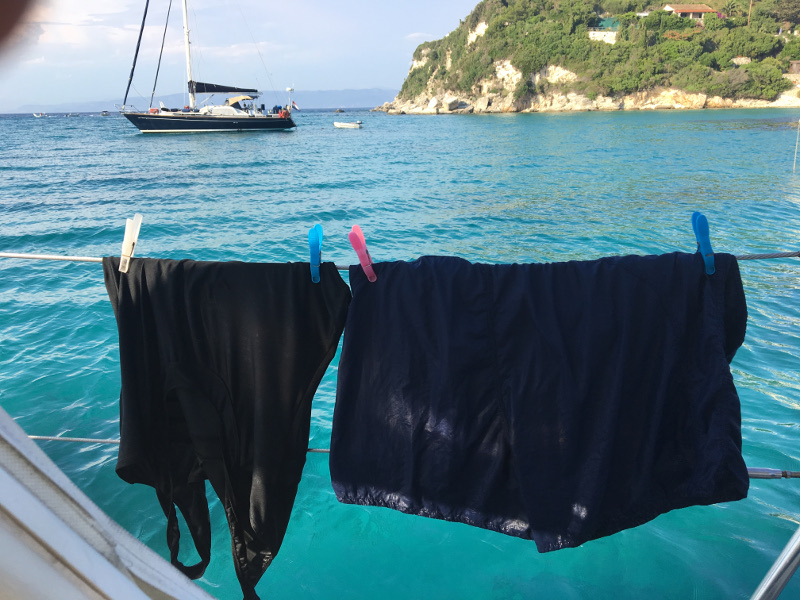
Despite the fact that we were both burned by lion’s mane jellyfish we could not withstand the turquoise green bathing water
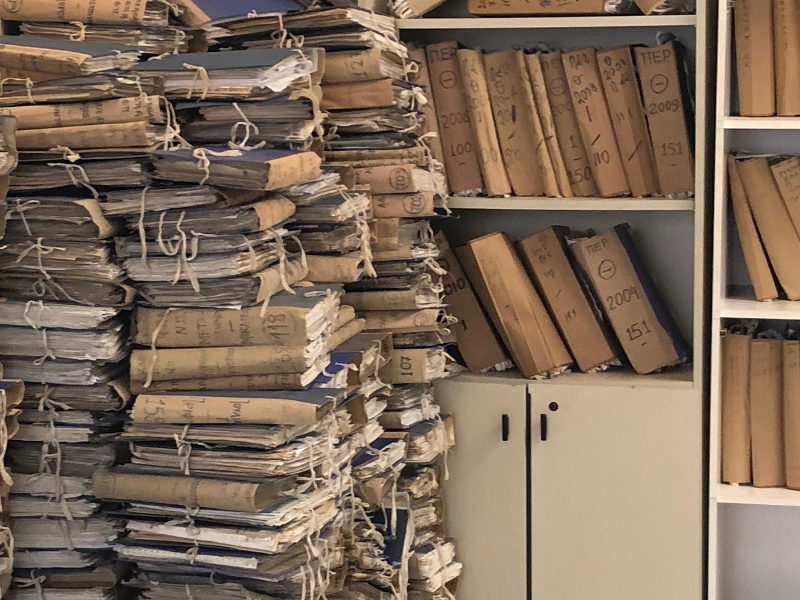
Crossing between smiles and beautiful women, this is how you get a Greek sailing certificate
39° 37′ 48.9” N 19° 54′ 4.6944” E
May 17th
She is young, beautiful and absolutely professional when she – with only the hint of a smile – gives me the document, she just wrote, printed, stamped twice and signed once. “Here you are, Sir,” she says, explaining that the very first thing, that is going to happen is that I shall pay 15 euros to get into Greece.
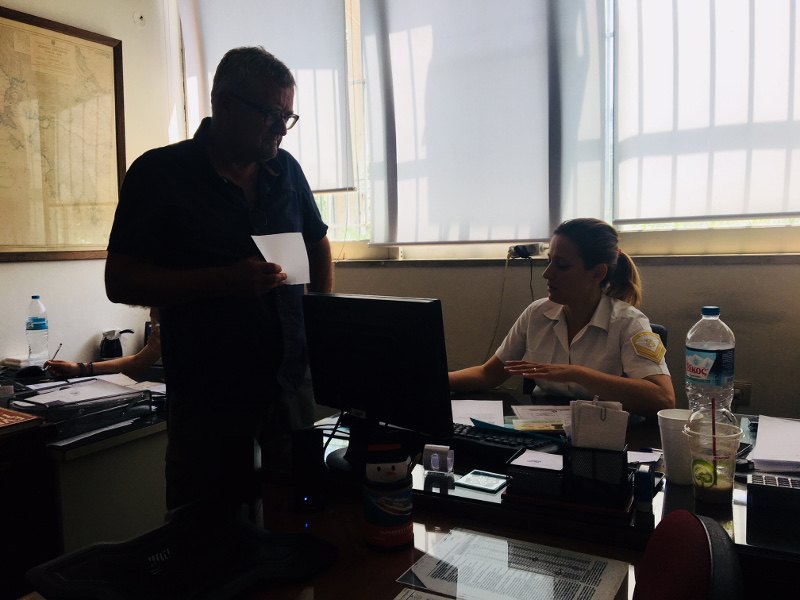
First office. First day. At a time when I am not aware of how many offices, I have to visit to get my DEKPA-paper
I take 15 euros from my pocket and pass them to her.
“No, no. Not here. You must go to office number 5 in order to pay. Return to the lobby, take the next corridor and go into office number 5. Once you have paid, you can come back to me.”
I walk down the next corridor, knock on a closed door and find a sweating officer, who apparently is stabilizing huge stacks of meters of papers and folders standing on his office floor, and seeming to be able to overturn every moment.
I explain that I have come to pay him 15 euros. Without words he finds a date block, asking me to fill in a few fields, then he stamps and signs. I pay 15 euros and return to start – to the beautiful customs officer in office number 7.
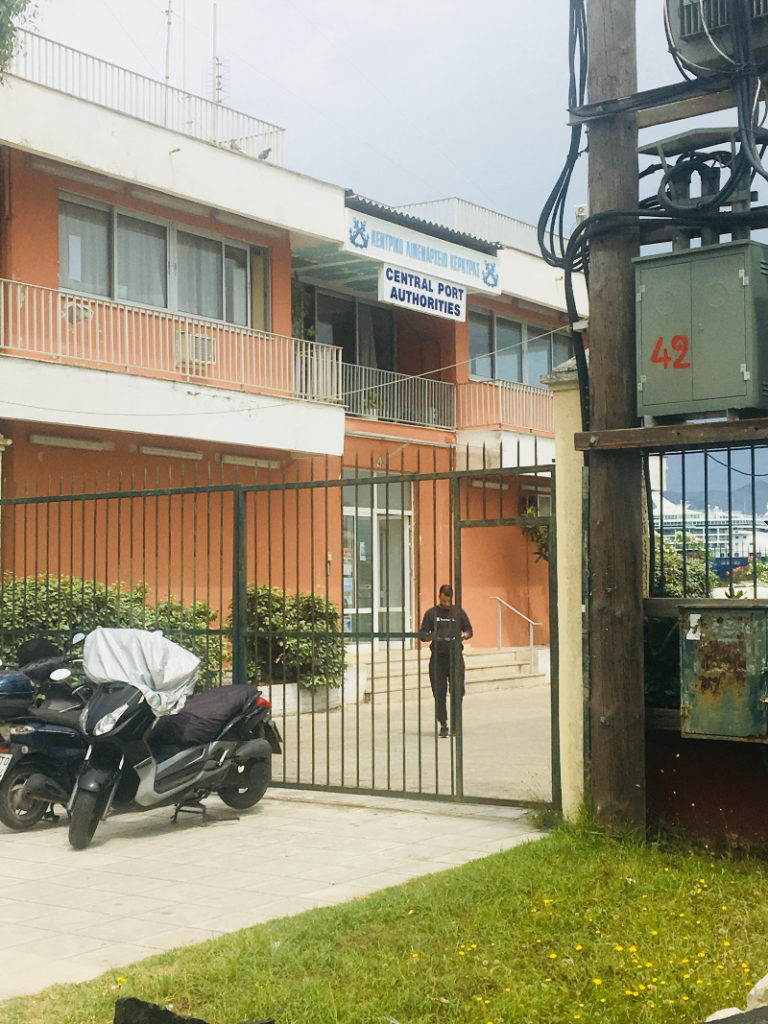
In Corfu the harbour police and the customs share one building to receive new sailors into Greece. Does that make it more easy for the sailors? That is yet to be proven
I am moving around in the Central Port Authority of Corfu, where customs and port police reside, and I am trying to get a so-called DEKPA document, which any foreign leisure boat over ten meters must have in order to sail in Greece waters.
“Well done,” nods the beautiful speaker acknowledging and accepts the receipt, that I have paid 15 euros. “Now hear this,” she explains. “The document I have made today is a temporary document, because you should have actually been at the tax office in Corfu Town to pay 50 euros for your DEKPA-certificate, and then you should have returned to me, and we could have finished the final document.”
But it is two o’clock, she explains. And at two o’clock p.m. the tax office closes. She gives me a Cyrillic city map, showing that the tax office is two kilometers from the Central Port Authority.
“Come back again tomorrow to office number 7, after you’ve been at the tax office,” she smiles.
Next morning I start at 9.30. I have entered the tax office’s address in Google Maps and I am led to a large, square building, that might look like a tax office. I enter through one of the two main entrances of the building and hope, it will lead me to the tax office.
All signposts are written in Greek with Cyrillic letters, I draw a number, get a seat in the waiting room, and when it is my turn, I walk freshly to the desk and ask in English: “Is this the tax office?”
No, the woman in the desk explains me kindly. “You must enter through the other main entrance of the building and go straight on to the first floor.”
How nice, I’m on track! On the first floor, I go down a corridor, still I have no clue of the Greek names for the task of each office, so I knock on the door to office number 1 and ask if they are the tax office? A woman explains that yes, they are, but the errand I come in, must be solved at office number 11, down the corridor, on the left.
I ask a few Greeks outside office number 11, if they are in line, but they shake their heads indicating, that they do not understand English. I am waiting patiently until I see that standing in a line, is not a core competence of the Greek people. New people show up, bust into the office directly, and when they discover that the office is busy, they back out and take the front position of the queue.
I’m making myself wide as a door, trying to fill the entire doorway as a signal, that I am hard to pass. While I wait, I study the office. Five women are in the office working with huge stacks of papers. They do have computers, but the computer-mouse is parked on top of the keyboard, and the tool they use most is the kind of fungus used to keep your finger wet, when you browse through many papers. Fascinating! I have not seen such a fungus on a desk for 30 years!
Only one of the women in the office is working with the citizens in the queue. At one point she comes past me and sees me standing in the doorway with my document in my hand. She looks at the document and says, that it’s completely wrong. They do not handle that kind of business number 11. I have to get back, enter another corridor just before the stairs. There they will be able to handle my case.
Thanks, I say, and then I go and find a huge office with lots of counters, but again not one sign to tell me where to go. I ask the first desk employee I meet, and she points me two counters further. “Number two employee from here. She is not here right now. But she’s coming soon. Just wait “.
I take my place in the queue in front of the empty counter and spend the time observing Greek office life. A man empties the rest of his coffee into a plant and goes to the coffee machine to pick up a new one. Another man looks a little to the right and then to the left, collects his cigarettes and matches and goes purposefully towards the exit.
Outside the windows a group of high school students are training a march with flutes, drums and a flag in front. All the tax office employees run to the windows to photograph. Something interesting is happening.
My “case manager” arrives. “Sorry, but my system is down,” she explains, and after some time of waiting she finally gets in touch with her IT-system again and prints my wish to pay 50 euros to the Greek tax authorities for a DEKPA-proof, and relieved I take 50 euros out of my pocket and hand them over to her.
“Not here,” she kindly explains. “You have to go to the cashier to pay.”
“She explains where the cashier is, and when I go to the cashier, she puts another six-seven stamps on the paper, takes my 50 euros, and then I go back to my “case-manager”, showing that I have paid 50 euros to the Greek tax office.
“Are we done?” “Yes, that was it.” More smiles.
Yes! I feel my document is within reach, and I hurry through Corfu Town down to the Central Port Authority to get my DEKPA proof. I open the door to office number 7 and safe of victory declares: “Here I have the proof, that I have paid 50 euros!”
The people in the office are different than yesterday and the new ones are skeptical to my tax document.
“You need to go to office number 8. We can’t issue the document, before it is approved by office number 8.
“I open the door to office number 8, where two port police officers reside. I’m addressing the female officer, once again a beautiful young woman in chic white uniform-skirt, white shoes and white uniform blouse. Again, the woman shows up to be highly professional and strongly accustomed to compliance with rules.
She wants to see my registration certificate for the boat.
“Well, I showed that to your colleague yesterday. Now I do not have it anymore, it lies with the port-manager of Port Mandraki. ”
“Sorry. I can not issue a DEKPA-certificate, if I do not see your registration certificate.”
I try to tell her about my passport, my insurance papers and documentation for yacht skipper- and VHF-training. But nothing could interest her less.
“Sorry. Registration Certificate!
“But listen, there are several kilometers to Port Mandraki!”
“Yes,” smiles the officer. “But we’re open all day. You can come back in the late afternoon.”
Smiles and beautiful women. I choose to smile as well, while I swear inside myself of the prehistoric bureaucracy of the Greeks.
Later, both Kirsten and I return with the registration certificate, opens the door to office number 8 and announces that we are back – this time with the registration certificate.
Then the writing begins. A DEKPA-paper is obviously a many pages long document. The officer completes something, I fill in some of the blanks.
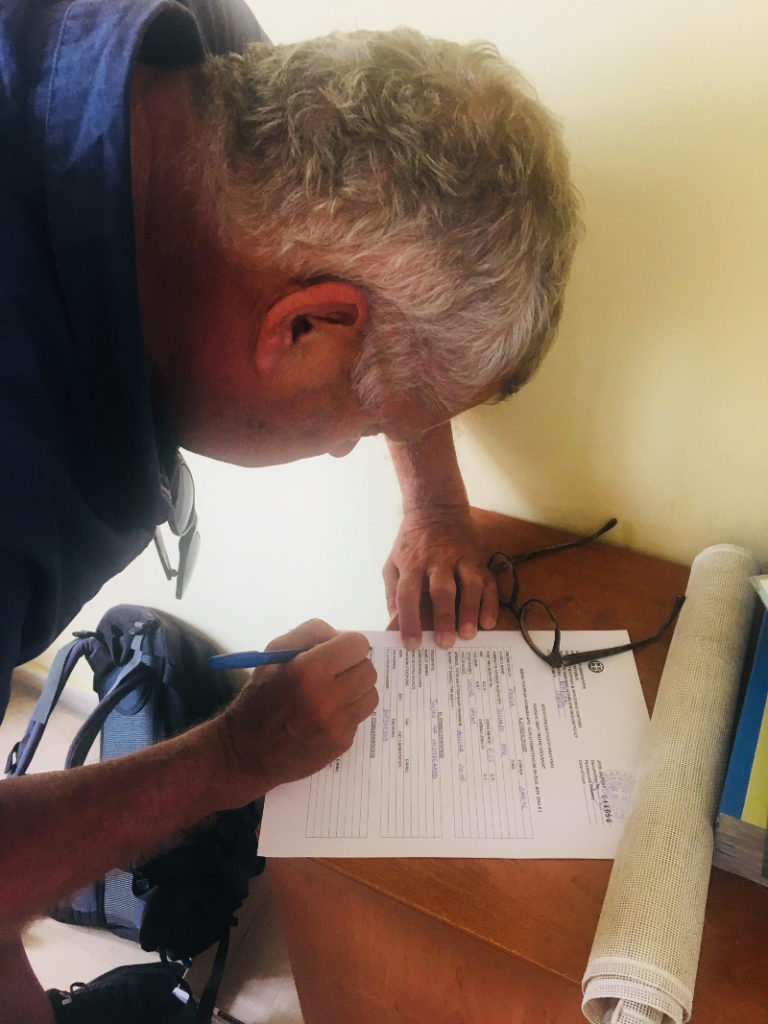
Quite a lot of the work you have to do yourself, but that seems okay. Precision is important
Finally, the paper gets four stamps, two signatures and it is copied. “Now you can go back to office number seven!”
At office number seven, there has been a shift of staff in the meanwhile, and the new customs officer does not know my case. She starts all over again. Certificate of registration, insurance, passport. It all gets copied. Questions are answered. The importance of the paper explained. Be sure to get it approved again in a year!
Thank you, thank you. We have passed the needle eye. After two half days, seven offices, a plethora of stamps, signatures, photocopies, an incomprehensible bureaucracy added with kindness and smiles, we now have a DEKPA proof.
The system has welcomed us to Greece, and the waters of the Greek islands is said to be the most beautiful, hospitable and enjoyable sailing ground in the world.
We are looking so much forward.
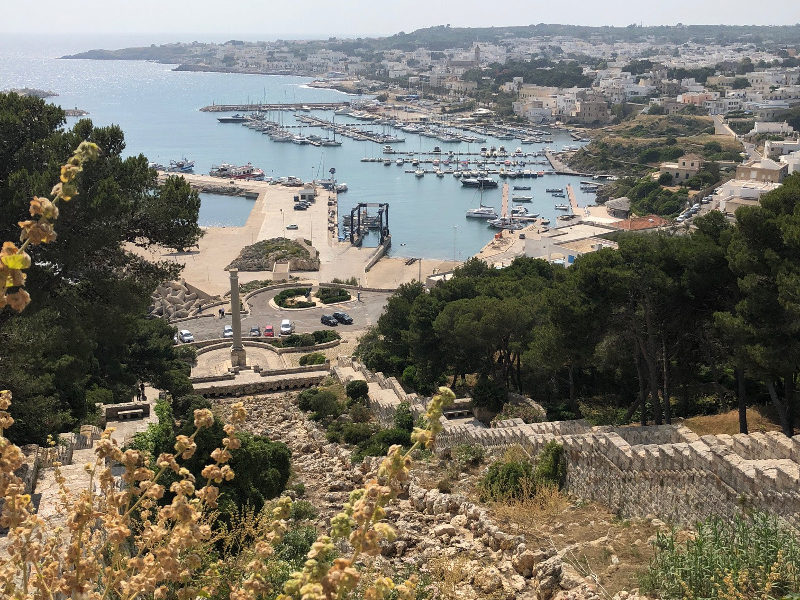
Italy´s worst harbour: Santa Maria Di Leuca
39° 47′ 45.7368” N 18° 21′ 40.8276” E
May 13th
Finally, we have reached the end of the country. Even the ancient Romans called Santa Maria di Leuca for “The Finibus Terrae”, which means the end of the country. We have reached the outermost part of the heel of the Italian boot, where further sailing to the east will inevitably bring you to either Greece or Albania. We choose – in the first place – Greece.
The port of Santa Maria di Leuca is lousy. It’s the most troubled harbour we’ve ever been in. Powerful moles are built, but apparently the authorities have forgotten to consult an engineer, because any wave of the ionic ocean propagates to a turmoil inside the harbour basin. Ronja jumps and dances. It pulls violently in the clamps, it rattles in wires and ropes and closets, and we are close to falling out of the bunk. Damned harbor. And the harbour office is completely unwilling to let us switch to one of the more quiet places in the basin – “they are reserved for big boats”, they let us know. And we do not see any big boats at all in the days, while we are waiting for better weather that can bring us out of Marina di Leuca and on to Greece. A completed lousy harbour. Zero stars out of five.
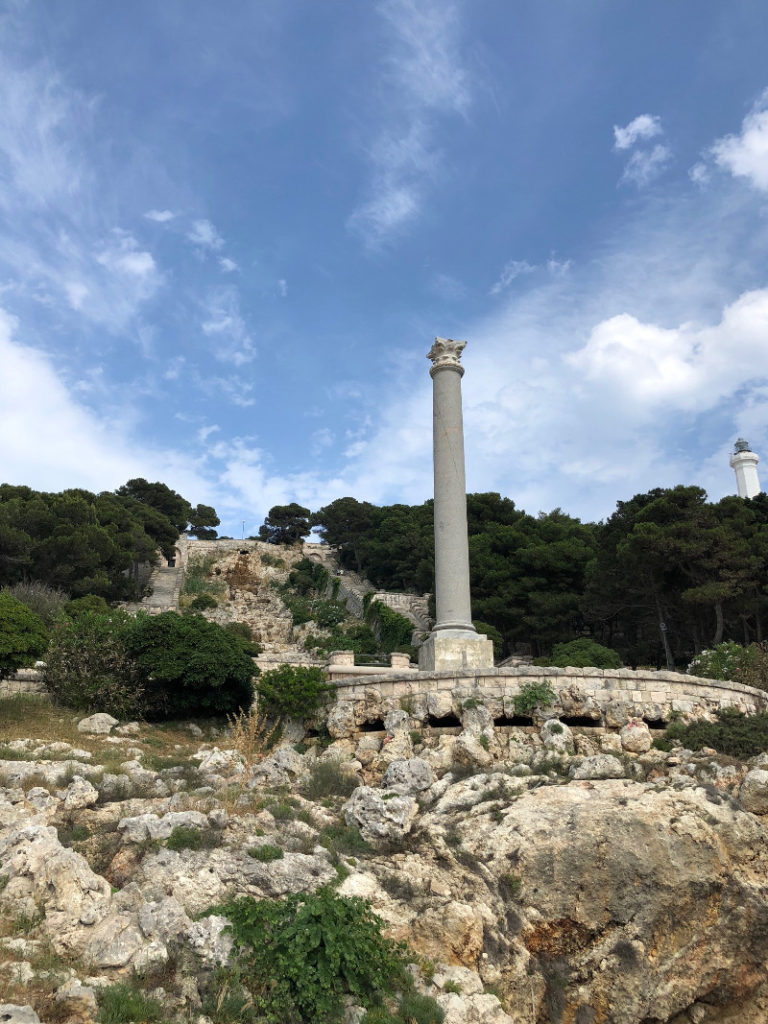
Mussolini insisted, that the greatest akvaduct of Europe should end in a waterfall, a monument and a 300 steps staircase, to welcome foreigners to Italy. A few times a year they still let out water from the top
That said, the city in itself is quite interesting. We see one of Mussolini’s prestigious projects, an aqueduct that ends in a waterfall and a 300-step staircase, as a kind of respect-giving portal to Italy. We see dozens of classical villas that make one think, that this could have been where the Roman senators in the times of Caesar went out for their summer holiday, but of course it is not, while these mansions probably have only three hundred years of history behind them. We inadvertently attend an Italian funeral. And we see a large number of peculiar installations along the coast, where busy businessmen have compensated for the missing beaches by building metal stands on top of the coastal lava cliffs and then coating the metal frames with wooden boards. And on these now there are several hundreds of sunbeds and umbrellas waiting for sunseeking tourists from northern Italy. Wooden beaches.
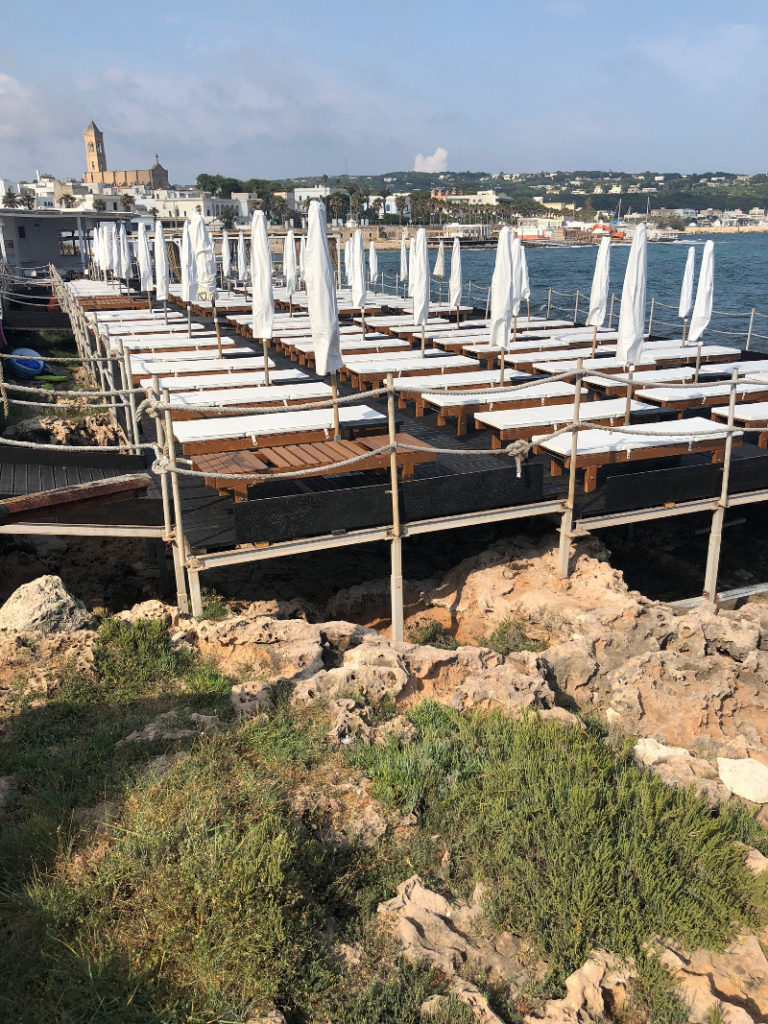
What to do if you do not have sandy beaches but “only” lava-cliffs? You build a wooden beach to support sunbeds and parasols
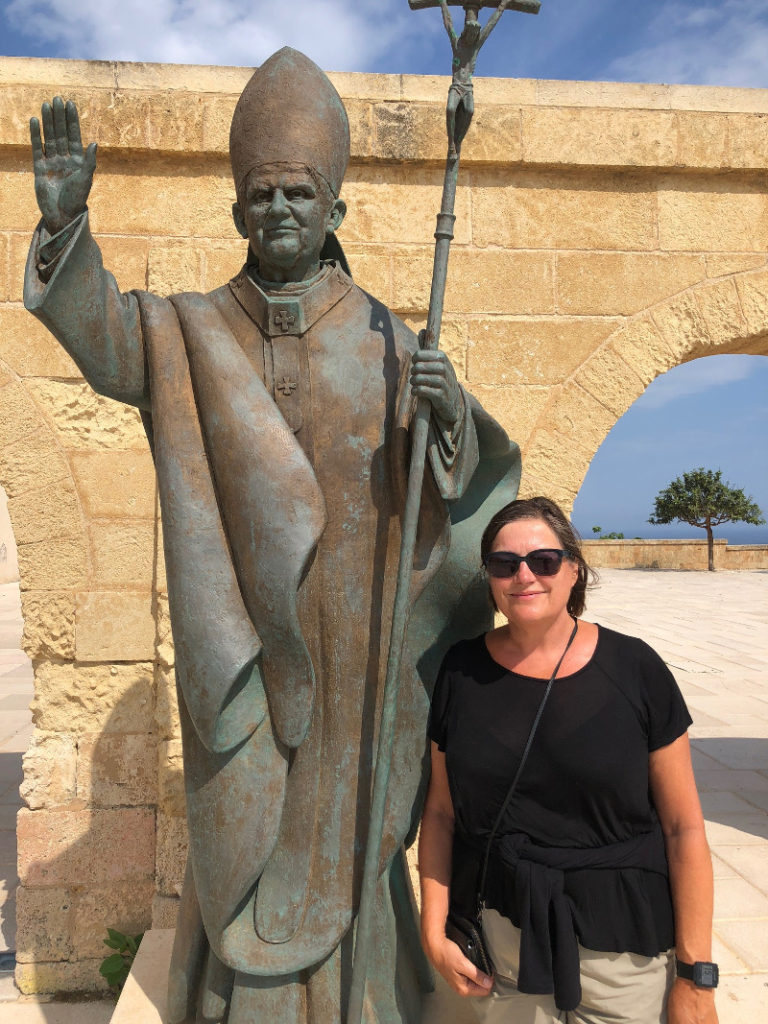
After visiting Santa Maria di Leuca in 2008 a statue of the pope was created. The pope is at the left
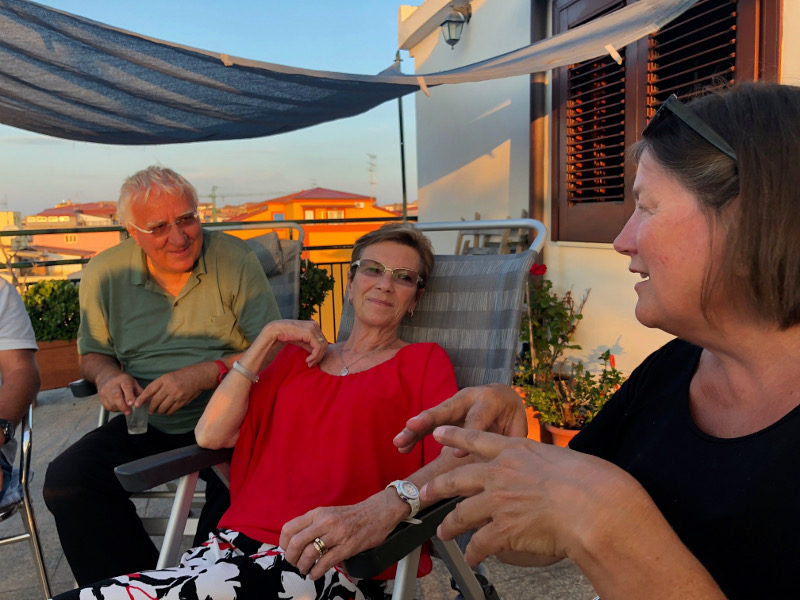
An invitation you can not refuse in Crotone
39° 4′ 44.4684” N 17° 8′ 16.278” E
May 11th
“Do you know that in Calabria it is an insult to say no, when a man invites you to his home? You can get away with that in Sicily. But not in Calabria.” The man behind these words seems quite compelling. His name is Pino, he is 70 years old, a big man, that speaks loud and deep and is remarkably good in English – and then he is from Calabria, born in the city of Crotone, to which city we have arrived with our good ship Ronja.
Pino has just invited us to his home, and this is of course wonderful, if it had not been because we had earlier said yes to an invitation to enjoy a drink with our British friends Claire and Derek as well as Elisabeth and Ken on board the boat “Pala”.
“Just bring them all,” Pino insists. “I have a small apartment but a big terrace. There can be a lot of guests on that terrace.”
“Do you also have a bus to drive us in?” I ask skeptically. “Yes, I have,” replies Pino, pointing to a minibus with nine passenger seats, that is parked at the quayside. He also has a Porche, a Ferrari, a motorcycle and a lot of other cars but hurries to add, that we should not think of him as a rich man. Because he is not.
With a blend of my Northern European factuality and Pinos more emotional arguing (“I am insulted, if you say no!”), we quickly convince Claire, Derek, Elisabeth and Ken to drop the planned drinks and instead go a long with Pino and his Danish-born wife, Helen, to their home in Crotone.
And of course, it turns out to be a wonderful experience. On a rooftop terrace on the 7th floor with a magnificent view over Crotone’s commercial port and the ionic sea, we enjoy Pinos and Helens boundless hospitality. We taste local specialties like brandy brewed on cactus flowers and brandy brewed on oranges. In addition bread, cheese and grilled peppers, and yes, some beer and wine to rinse after with. Helen enjoys speaking Danish with Kirsten and I, while Pino serves and talks about classic cars in English with our British friends.
Pino and Helen met in the 70’s, when they both worked in the EU. They still have a residence in Luxembourg, but spend more and more time in their apartment in Pinos childhood city, Crotone, where a daughter and a grandchild also live. And how did we meet Pino and Helen? Well, through the kind of coincidences, that fortunately the sailing life is so rich of. We were in Palermo with a Danish couple, Sten and Rie, for 14 days, and they told us, that if we came to Crotone in Calabria one day, we should contact their friends, Pino and Helen, and if we had some Danish books we had finished ourselves, we should give them to Helen, because she loves to read Danish books but rarely has the opportunity to do that.
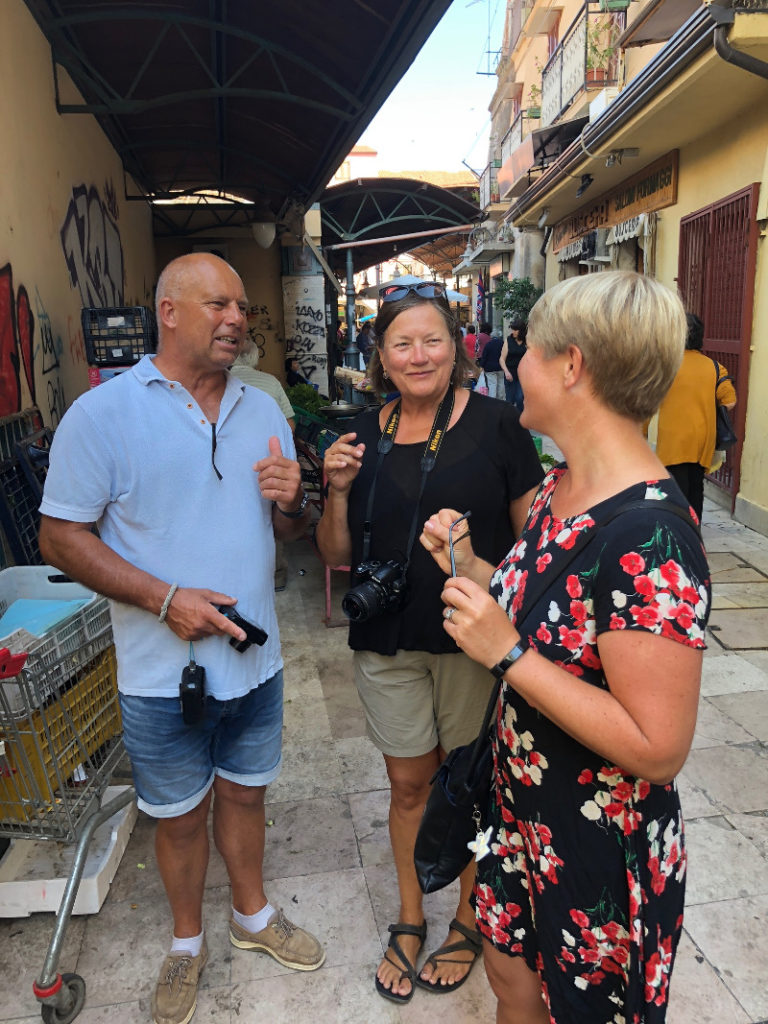
Derek, Kirsten and Claire in the charming and lively market of Crotone
Crotone is a wonderful city. From the outside, the eye first meets a number of gas extraction platforms and a large commercial port. But the city has history, culture, beaches, a big fortress with an old city within its walls, as well as a very lively market. Very charming. It is a city we definitely will return to. And by that time not just for two days.
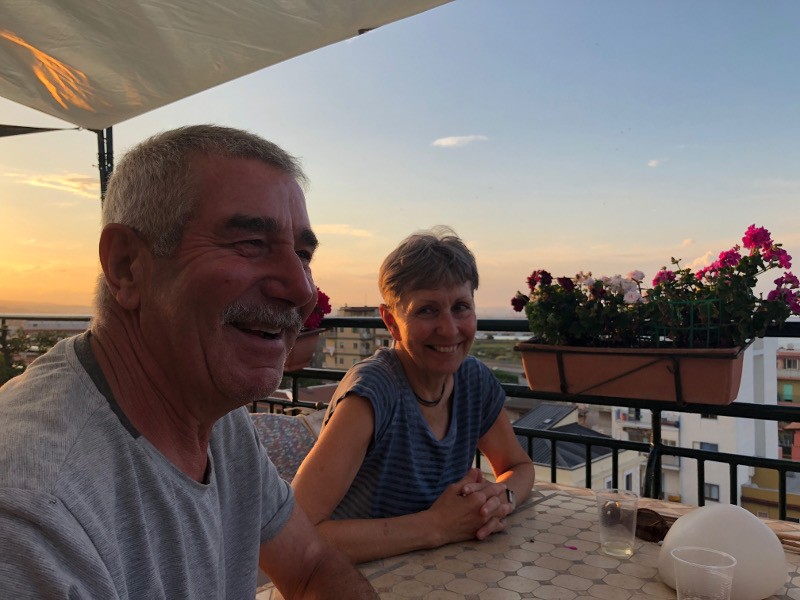
British saylors, Ken and Elisabeth, following the same route to Greece as we are. Here at Pino and Helens 7th floor terrace
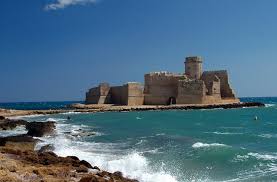
La Castella
38° 54′ 38.9772” N 17° 1′ 36.0912” E
May 10th
Nice little port for one night. A bit difficult to enter the marina because of underwater stones. Cheap but then again it is not a port you choose for its standard in toilet and shower conditions. We buy provisions in the small town, sleep and then sail on.
